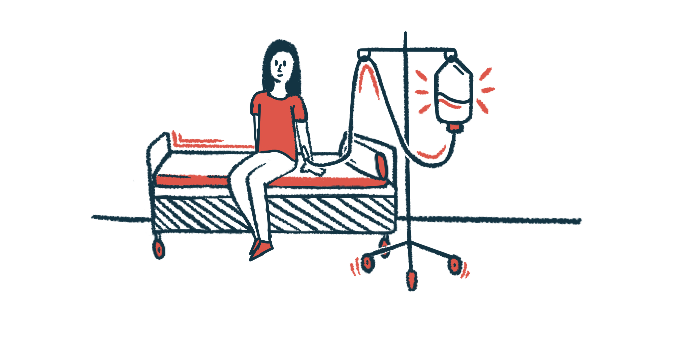Plasma exchange effective in elderly NMOSD patients: Study
Researchers in China analyze data from NMOSD patients grouped by age
Written by |

Plasma exchange, a blood-cleaning procedure, is safe and helps to ease symptoms in elderly people with neuromyelitis optica spectrum disorder (NMOSD), despite the presence of other health conditions.
That finding is from a Chinese study that assessed the safety and efficacy of plasma exchange in elderly NMOSD patients (older than 60 years) versus younger ones.
Severe inflammation in the optic nerve, which relays information between the eye and the brain, among elderly patients was a predictor for poor response to plasma exchange. For this particular patient group, or any patient showing no or delayed response, “earlier initiation of escalating or sequential therapies is highly recommended,” the researchers wrote.
The study, “Therapeutic efficacy and safety of plasmapheresis in elderly patients with neuromyelitis optica spectrum disorder: a single-center observational study,” was published in the journal Therapeutic Advances in Neurological Disorders.
NMOSD is caused by the immune system abnormally producing self-reactive antibodies, or autoantibodies, that attack healthy nervous system cells. Most patients have high levels of autoantibodies against the AQP4 protein — a diagnostic hallmark of NMOSD.
This abnormal immune attack leads to inflammation in the optic nerve (optic neuritis) and the spinal cord, resulting in symptoms such as vision problems, muscle weakness, and pain.
While the disease most often affects young adult women, “the prevalence of elderly-onset NMOSD has been recognized as increasing worldwide,” the researchers wrote, adding that disease relapses are more severe in elderly patients.
Despite early and intensive treatment being viewed as paramount to prevent NMOSD relapses and their associated disability regardless of patient age, treating older patients can be challenging due to the presence of other health conditions and the risk of treatment side effects.
Plasma exchange, or plasmapheresis, is a therapeutic approach used to clean the blood by removing and replacing a person’s plasma — the liquid portion of blood that contains water, salts, and proteins, such as antibodies.
Since this process can remove NMOSD-driving autoantibodies, it has the potential to help prevent further disabling relapses, and several reports have suggested its beneficial effects in this patient population.
Plasma exchange has no age restrictions, but its invasive nature may increase the risk of adverse events among elderly patients. For now, the outcomes of plasma exchange in older NMOSD patients remain largely unknown.
Analyzing the data
Now, a team of researchers in China retrospectively analyzed data from 76 NMOSD patients who received at least one session of plasma exchange treatment and underwent evaluation at least six months after the last session.
All received such treatment after being hospitalized at the China-Japan Friendship Hospital between October 2010 and July 2022.
The criteria for plasma exchange included contraindication to into-the-vein methylprednisolone (IVMP), an anti-inflammatory and immunosuppressive therapy, and intravenous immunoglobulin (IVIG), or limited response to either of them.
IVIG delivers specific antibodies purified from healthy people to neutralize self-reactive antibodies in the bloodstream and block these antibodies’ abnormal production. Plasma exchange also was considered if a patient experienced a severe disabling attack.
Grouped by age
Patients were divided into two groups according to whether they were younger than 60 years. A total of 50 patients comprised the younger group, while the remaining 26 patients were 60 or older (mean age, 67.7) and comprised the elderly group (88.5% women).
A significantly greater proportion of elderly patients had additional health conditions compared with the younger group (69.2% vs. 12%). More than a third of elderly patients had high blood pressure and more than a quarter had cardiovascular disease due to thickening or hardening of the arteries; these conditions were not present in the younger group.
The use of therapies other than immunosuppressants was significantly more common in the elderly group (65.4% vs. 10%). No differences between the groups were seen regarding symptom onset, disease duration, disability at plasma exchange, or anti-AQP4 antibody levels, among other features.
Responders to plasma exchange were classified as those showing a complete-to-moderate resolution of attack symptoms and a reduction in Expanded Disability Status Scale (EDSS) or visual outcome scale (VOS) scores by at least 30%. EDSS assesses disability and VOS quantifies visual acuity; in both cases, higher scores indicate worse outcomes.
Data at six months after the last plasma exchange session showed that 96% of the elderly patients improved their condition, with 60% deemed as treatment responders.
Among the elderly patients who previously received IVMP and/or IVIG, the EDSS score reduction was significantly higher six months following plasma exchange (by 48.3% vs. 2.4%). The same was seen for the VOS scores (a 30.1% vs. 6.3% reduction).
Also, five of six (83.3%) elderly patients who experienced severe optic neuritis attack showed mild-to-no improvement at six months after plasma exchange. Statistical analyses revealed that this severe event was a significant, independent predictor of poor response to plasma exchange.
The treatment sessions were generally tolerated well among the elderly, with similar rates and number of adverse events between the age groups. Temporary low blood pressure after the first session occurred more frequently in the elderly group (19.2% vs. 4%).
‘Safe and effective’
Overall, plasma exchange “appears safe and effective for elderly patients with NMOSD and should be considered an option during attacks when initial therapies fail or during severe relapse,Chinese researchers analyze date from patients” the researchers wrote.
Preventive measures against low blood pressure before initiating plasma exchange therapy is recommended for elderly NMOSD patients, the team concluded.






